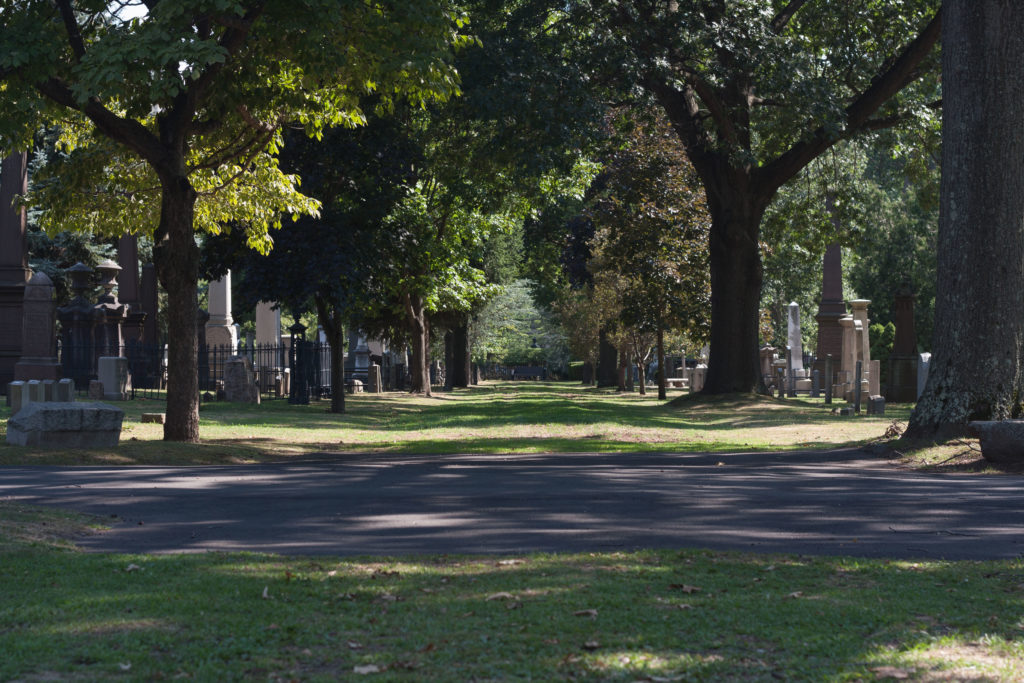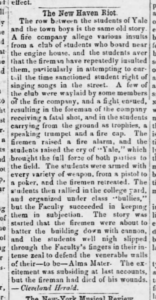Have a drink with: The Yale Medical School Class of 1824
Did you bring a shovel?
Ask them about: Buying your own school supplies
On a cold January morning almost 200 years ago in New Haven, Connecticut, someone came knocking on Jonathan Knight’s door. This itself was not necessarily unusual, as Knight had his thumb in many of the town’s proverbial pies: in addition to serving as a local doctor, he was also a professor at the young Medical Institution of Yale College. What was unusual, for the pre-breakfast slot on a Monday morning, was that the caller was a lawyer named General Kimberly, and that he was deeply concerned that some of the school’s medical students had apparently and emphatically not spent their Sunday at church.
Kimberly reported that, sometime between Saturday night and Sunday morning, someone had opened a fresh grave at the cemetery in nearby West Haven, and removed the corpse of a recently deceased young woman. News spread quickly around town after the site was discovered in disarray, and while no one knew who might be responsible, the students of the Medical Institution were immediately and specifically targeted for suspicion.
A constable soon joined the men at Dr. Knight’s house, and the three made their way over to the medical school, dearly hoping that there was nothing to find. Grave robbery, though not uncommon in the era, was nonetheless viewed with a particular horror amplified by New Haven’s sober Puritan origins. Surviving letters written by the constable, the snappily-named Erastus Osborn, describe what happened next: the men searched the school from “bottom to top,” and while at first they found nothing, Osborn thought a faint disturbance in the dirt on the cellar floor seemed odd, and scraped at it with his walking stick. Taking up a flat stone in the floor, the men “discover’d a while bundle, apparently a bundle of cloathes. We examin’d & found a human body doubled up in a heap entirely cover’d up with the grave clothes.”*
The men had the body identified, cleaned and dressed, and loaded the corpse into a wagon for transport home to grateful family members. By then, curious crowds lined the New Haven Green, and became increasingly agitated as the wagon passed down Chapel Street – “all the while,” Osborn wrote, “people were wrought up to a great pitch, and the Town is full of stories.”
The medical students were not exactly feeling great about the day’s events, and with good reason shut themselves up inside their dorms: Osborn’s letter claims that drums beat outside, and the town streets were choked with “the besieging army preparing for the assault.” (For his part, Osborn said screw it: “I intend to keep at Home & let the ferment have event or subside.”) Almost every night throughout the week, angry New Haven residents either protested or outright attacked the medical school building, assaults that only let up when one particular student was brought into court to account for the crime (two others skipped town before questions could attach).
As there were no witnesses to the crime, it is entirely unclear whether Ephraim Colborn had anything to do with the body-snatching, and history largely suggests that he was offered up as a scapegoat to satisfy local demand for emotional closure and civil order. Colborn pleaded not guilty but was convicted to nine months in jail and a $300 fine. That same year the Connecticut legislature introduced a new law into the general statutes, entitled “An Act to prevent the disinterment of the bodies of deceased persons.”
(Body-snatching is still illegal in Connecticut.)
Fun Facts:
The corpse in question was the body of Bathsheba Smith, the 19-year-old daughter of a local farmer, and unfortunately little more than this is known about her or her family.
Concern over grave robbing was very real in the 19th century, with “resurrectionists” or ransomers engaging in the practice. This led among other things to the development of patented devices to spring-load your grave with explosives or buckshot, like some sort of Elmer Fudd contraption. These “grave torpedoes” are more impressive in concept than execution, and by all accounts were used far less than the practical tactic of having someone, you know, keep an eye on a gravesite for a few days.
Old rumors at the Yale Medical School suggested that it wasn’t just coincidence that the school’s original building, a renovated hotel known as Sheffield Hall, was situated across the street from the historic Grove Street Cemetery. Moreover, some people would tell you there was even an underground tunnel between one and the other. The medical school, at the time of the 1824 riot, was situated at the corner of Grove and Prospect streets, the current site of Yale’s Sterling-Sheffield-Strathcona building.
Since 19th century Americans would use most anything (the Civil War; a night at the theater; Christmas) as an occasion to have a good riot, it’s worth mentioning that this was not the only town-gown squabble at Yale, nor the most raucous. An ongoing squabble between students and local firemen escalated to the point that in 1858, cannons were involved:
Additional Reading:
Kristina Killgrove, “How Grave Robbers And Medical Students Helped Dehumanize 19th Century Blacks And The Poor,” Forbes, July 13, 2015
Miss Cellania, “The Era of the Body Snatchers,” Mental Floss, October 16, 2014
* Hannibal Hamlin, “The Dissection Riot of 1824 and the Connecticut Anatomical Law,” Yale Journal of Biology and Medicine, v.7, n.4 (1935)
Michael Bielawa, Haunted New Haven (2013)

